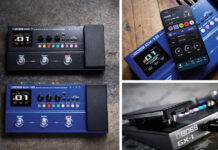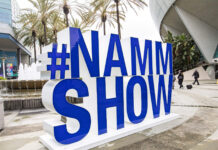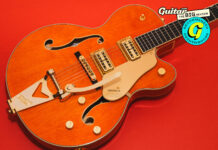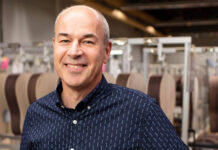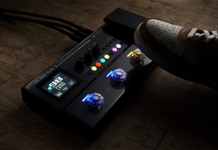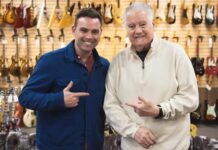
“It’s still a hot-rod shop here!”: Ron Thorn of Fender Custom Shop
The boutique guitar world is rife with specialists: the guy who does modern set-neck fusion machines, or down ‘n’ dirty rock warriors, or presentation guitars resplendent with exotic woods and elaborate inlays, or hot-rodded reimaginings of the classic bolt-necks. Ron Thorn does all of the above, and more and he nails down everything he touches with a rare blend of precision and soul. No wonder the Fender Custom Shop snapped him up as a Principal Master Builder.
In addition to the bottomless talent and unfettered creativity he brings to the Custom Shop, Thorn also brings some impressive statistics. No previous Master Builder has come directly into the ranks from outside Fender since the inception of the institution at the hands of co-founding Master Builder Mike Stevens. Plus, to our knowledge, none has built as many guitars as an independent maker as Thorn did prior to his move to the Custom Shop (some 800 in total), while also maintaining a business as one of the world’s most renowned inlay artists.
It would also be safe to say that none honed their chops making guitars that diverged so widely, even radically, from the traditional Fender formula. A 24-fret, set-neck double-cut with carved bookmatched top in flamed koa, multicoloured Koi inlaid into its ebony fingerboard, abalone purfling ringing its body, fingerboard and headstock and Brazilian-rosewood humbucker bobbin tops and knobs? Yes indeed.
But Thorn can also turn out a bolt-neck, single-cut, Cabronita-style twang monster in matte black with pinstriping and Dia De Los Muertos graphics, and show just as much excitement in the process. Take that kind of artistry, put a Fender decal on it, and inject it into the existing powerhouse that is the Custom Shop, and the sky’s the limit.
It’s also worth noting that Ron Thorn is one of the nicest guys you’ll ever meet, anywhere, in any walk of life and has a deep, easy, enthusiastic laugh that bubbles forth whenever the subject really tickles his fancy. Make of that what you will, but the world could definitely use a lot more of it.
O Canada!
Asked how it feels to have a bench in such hallowed ground in the guitar world, on this the near-anniversary of his first year with the Custom Shop, Ron Thorn simply says: “It’s amazing! And just the sheer comradery – most guys here play guitar, so they’re just nerded out. It doesn’t matter what job they have, they can be sanders, fret installers, there are some really good players here, and they’re so proud to be working on Fenders. And I’m right there with them. It’s a great product, and everybody’s thrilled by it.”
It was a long road to get there, though, and the trek began north of the border. Born in Brampton, Ontario, Canada – “in the summer of ’69, the week before Woodstock” – the young Thorn was immersed in both music and woodworking practically before he could walk.
“My brother is 10 years older,” he tells us, “so all throughout the 70s, say, I’m six and he’s 16, so you can imagine the musical influences he was bombarding me with: Zeppelin, Rush, Max Webster, Queen. I was just hit with all the good music at an early age, which certainly helped shape my future.”
Thorn’s grandfather and two of his uncles were finish carpenters by trade and his father, an armourer for the Royal Canadian Navy, was skilled enough in the craft to maintain a comprehensive wood shop in the garage of the family home, in which he constructed all of the furniture in the house. As Thorn puts it: “I didn’t realise that wasn’t the norm until taking woods and metals in junior high. I went in there knowing how to operate every piece of machinery and my friends are just on the brink of cutting their thumbs off. I didn’t realise that, ‘Oh, you all don’t have wood shops in your garage? That’s peculiar!’”
In 1979, Thorn senior accepted a new job in Burbank, California and took the family with him, and it was there on the West Coast where the revolution in electric-guitar design had first been televised three decades before that junior really started putting the wood, the metal and the music together.
At the age of 13, a friend from junior high gave him the neck and tuners from an imported Japanese Prestige model guitar from the 60s and within a week, he and his dad had built a body and he had fabricated a pickguard and a string-through bridge in metals class. The electronics, though, would have to be sourced elsewhere.
Do you want to sound like him?
“This was 1982,” says Thorn, “and Van Halen’s at their peak. And I specifically recall walking to Killeen Music in Burbank, where I told the guy: ‘I need a pickup.’ He asked what kind of guitar it was for, and I told him it was home-made, so it didn’t really matter. And he points to the picture of Eddie Van Halen on my ’81 tour jersey and says: ‘Do you want to sound like him?’ as he slides the Duncan humbucker across the counter top. I was just like, ‘Yeeeesssss…’ I grabbed it and my feet never touched the ground on the way home, to get that thing whacked in there and wired up.”
And so it began. Thorn worked his way up from that first DIY job to modifying the Ibanezes and other guitars popular with kids back in the day, and quickly became the go-to guy in high school for repairs, modifications, installations of locking Floyd Rose and Kahler vibratos, and the rest of it. “Lots of humbuckers slammed into Strats,” he recalls. “That whole routine.”
After studying mechanical engineering, he took a job as engineering manager for a custom machinery company in Southern California, where he learned how to program and operate CNC machine tools. Meanwhile, in the evenings, he was building guitars at home in his dad’s shop. And this was when the desire took hold to add a little more artistry to craft.
The inlay guy
“I wanted to take it a little further and do some inlay work,” Thorn says, “and I built this neck-through guitar and decided I wanted to do a Chinese dragon inlay on it. So I bought all the supplies and stuff from Stew-Mac, and bought some sterling silver from the jewellery district in LA, and every day after work would just spend a few hours hand-cutting these scales and inlaying this dragon. It took months and months and after it was completed, I took the entire guitar to G&W Guitarworks. They used to run a little ad in The Recycler magazine that said: ‘We Paint Guitars!’
“I laid it on the counter, and Lee Garver looked at it and said”: ‘Who did the inlay work?’ I said: ‘I did. And I built the whole thing from scratch.’ Two hours later, I left with a dozen necks and fretboards under my arm to inlay, just like that. I suddenly had a side gig doing inlay work. Because there were very few people in the country that did it, let alone in Southern California, so word got out quick. Next thing I know, I’m doing stuff for Ibanez Custom Shop, Schecter Custom Shop, anybody local. Yamaha has a custom shop here, ESP, all the small little local custom shops. And then around ’95 or ’96, I got my foot in the door at the Fender Custom Shop and that was a huge career change.”
Indeed. For more than two decades, Thorn, with frequent assistance from his dad, who’d recently retired, did all of the Fender Custom Shop’s custom inlay work. The effort, along with the rest of the inlay jobs coming in, necessitated him leaving his erstwhile ‘day job’ to take up inlay work full-time in 1999. A year later, he officially launched Thorn Guitars, with his own logo and all, and soon the full builds came along at a pace to rival the inlay commissions.
From exotics to bolt necks
As the predominant style of his early builds might indicate, Thorn initially got a lot of his custom-guitar commissions from players spinning off the popularity of Paul Reed Smith.
“It took off quick via the PRS Forum, and then it segued into the Gear Page,” he recalls. “Because my initial guitars were very PRS-like in terms of being double-cut carved tops, lots of inlay. I’m not even sure if the [PRS] Private Stock program was around at that time, or if it was it was very early and it gave a lot of guys the opportunity to have something similar, yet fully custom. And that was hot back then, too. Lots of inlay, and lots of exotic woods. And I was doing wood P-90 covers and wood bobbins, lots of details that either hadn’t done or were very rare to see.”
Image: Thorn Custom GuitarsSuch popularity can be perilous for a small shop, though, and the time came when Thorn just couldn’t keep up. In 2009, he took stock and found himself back-ordered for 140 of his Artisan Master model guitars; maintaining the status quo simply wasn’t feasible.
“Every one of those on order was extremely custom,” Thorn says, “and the lead time became unpredictable. ‘Five years? 10 years? I don’t even know, buddy!’ There was just no way to predict how long it would take. ‘You’re guitar number 141 now, and guitar 137 has a huge aquarium inlay theme, so…’”
The solution was the launch of his SoCal line, which allowed Thorn to keep building new guitars, and stay sane while still hammering away at the pre-ordered Artisans. Rendered in four body styles, including Tele-, Strat-, and super-Strat-like shapes plus his own original offset California Special design, the SoCals were overtly more Fender-inspired, in a range of single coil and humbucker-loaded configurations. They were built with bolt-neck construction, albeit with Thorn’s own highly engineered ‘Precision Lock’ custom dovetail lap neck joint.
“There were no elaborate custom inlays,” says Ron, “and they were essentially easier instruments to build in that they’re not carve tops and there wasn’t a whole lot of custom implementation. But, as you can see if you look at the gallery, they started fairly traditional, and of course [laughs] they start getting a little more ‘out there’ and a little more elaborate.”
Fender calling
If it was at first daunting making the move from being his own boss and building whatever style of guitar he felt like, to being part of a world-striding guitar powerhouse that mainly pushed out a limited selection of core models, Thorn has nonetheless been able to fully express himself creatively within the Fender fold. Even beyond that, fans of his previous work should be delighted by the extent to which Fender has embraced several of Thorn’s bold signature moves.
“I was afraid that, ‘Oh boy, here we go. I’m going to be building ’52 Teles and ’65 Strats for the rest of my life!’” Thorn tells us. “But no, that couldn’t be further from the truth. Let’s put it this way: no one has said ‘don’t do that’ to me yet.”
More to the point, the Custom Shop’s open-armed reception of Thorn’s skill and ethos seems to have taken very much a ‘do do that’ line. From programming Fender’s CNCs, to developing new tooling, to introducing an entirely new vibrato design to the Fender catalogue (the VibraDyne, paired with Thorn’s own Brass Knuckle bridge design), to building the first new Coronados made in the USA since the early 80s, to entirely revamping almost every aspect of the fretting shop, Thorn has already played a major role in the works above and beyond the guitars he himself has created as Principal Master Builder. And even there, a major dose of Thorn continues to shine through beneath the iconic Fender logo.
Take, for example, the sly introduction of his own California Special as one of the first new Fender body shapes in aeons to join the iconic lineup of Telecaster, Stratocaster, Jazzmaster and Mustang. Thorn takes up the tale…
View this post on Instagram
The only relic’d guitar I’m bringing to NAMM, a California Special in 2-Tone burst, Vibra-Dyne + J-Bridge, Fat 50’s, Brazilian board, Bakelite guard. Killer relic by @javirelics and @deakonlekross – thanks guys! #fendercustomshop #fender #masterbuilt #californiaspecial #vibra-dyne #namm2019
A post shared by Ron Thorn (@thornguitars) on Jan 19, 2019 at 4:56pm PST
“Here’s the truth. We got an email in June or July, saying: ‘The NAMM Show’s coming up, start working on your NAMM Show stuff! The space allotment’s approximately a half-dozen guitars, so build whatever you want, and make them Fenders.’ That’s how it read, period. So I’m just, ‘I’m doin’ it, and if I get in trouble, so be it!’ I ran the bodies myself on the CNC in the wee hours. I was assembling it on my bench when my director, Chris Fleming, comes in and goes: ‘What’s that?’ And I kind of felt caught. My face got red a little bit, but man, it’s painted, I’m putting it together, and I just said: ‘It’s called the California Special.’ And he just looks at me and goes: ‘Huh. How’d you do that?’ and walked away.
“And I was kinda like, ‘I guess it’s going to the show. I guess it’s good to go!’ We took orders for them and I was answering questions from the sales guys, so I was like, ‘Okay, it’s in the mix now!’ So, it’s a model that can only be ordered Master Built through me as a builder, for now, though it’d be fine with me if any of the other guys wanted to do them.”
Fender is a big corporation, but so far, Ron Thorn has not found the typical attitude we associate with such levels of business to be reflected at all in the work going on in the trenches. Or, as he puts it: “It’s still a hot-rod shop here. These guys are still willing to take chances, and are digging it, and are cool about it. Everybody’s a player. No one wears a tie here.”
Stay tuned to our feature on Ron Thorn’s
The post “It’s still a hot-rod shop here!”: Ron Thorn of Fender Custom Shop appeared first on Guitar.com | All Things Guitar.
Source: www.guitar-bass.net

